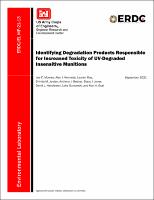Please use this identifier to cite or link to this item:
https://hdl.handle.net/11681/42020| Title: | Identifying degradation products responsible for increased toxicity of UV-degraded insensitive munitions |
| Authors: | Moores, Lee C. Kennedy, Alan James, 1976- May, Lauren R. Jordan, Shinita M. Bednar, Anthony J. Jones, Stacy J. Henderson, David L. Gurtowski, Luke A. Gust, Kurt A. |
| Keywords: | Nitroguanidine Cyanide Nitrosoguanidine Daphnia pulex Toxicity IMX-101 |
| Publisher: | Environmental Laboratory (U.S.) Engineer Research and Development Center (U.S.) |
| Series/Report no.: | Miscellaneous Paper (Engineer Research and Development Center (U.S.)) ; no. ERDC/EL MP-21-13 |
| Is Version Of: | Moores, Lee C., Alan J. Kennedy, Lauren May, Shinita M. Jordan, Anthony J. Bednar, Stacy J. Jones, David L. Henderson, Luke Gurtowski, and Kurt A. Gust. "Identifying degradation products responsible for increased toxicity of UV-Degraded insensitive munitions." Chemosphere 240 (2020): 124958. https://doi.org/10.1016/j.chemosphere.2019.124958 |
| Abstract: | Degradation of insensitive munitions (IMs) by ultraviolet (UV) light has become a concern following observations that some UV-degradation products have increased toxicity relative to parent compounds in aquatic organisms. This investigation focused on the Army's IM formulation, IMX-101, composed of three IM constituents: 2,4-dinitroanisole (DNAN), 3-nitro-1,2,4-triazol-5-one (NTO), and nitroguanidine (NQ). The IM constituents and IMX-101 were irradiated in a UV photo-reactor and then administered to Daphnia pulex in acute (48 h) exposures comparing toxicities relative to the parent materials. UV-degradation of DNAN had little effect on mortality whereas mortality for UV-degraded NTO and NQ increased by factors of 40.3 and 1240, making UV-degraded NQ the principle driver of toxicity when IMX-101 is UV-degraded. Toxicity investigations for specific products formed during UV-degradation of NQ, confirmed greater toxicity than the parent NQ for degradation products. Summation of the individual toxic units for the complete set of individually measured UV-degradation products identified for NQ only accounted for 25% of the overall toxicity measured in the exposures to the UV-degraded NQ product mixture. Given the underestimation of toxicity using the sum toxic units for the individually measured UV-degradation products of NQ, we conclude that: (1) other unidentified NQ degradation products contributed principally to toxicity and/or (2) synergistic toxicological interactions occurred among the NQ degradation product mixture that exacerbated toxicity. |
| Description: | Miscellaneous Paper |
| Gov't Doc #: | ERDC/EL MP-21-13 |
| Rights: | Approved for Public Release; Distribution is Unlimited |
| URI: | https://hdl.handle.net/11681/42020 http://dx.doi.org/10.21079/11681/42020 |
| Appears in Collections: | Miscellaneous Paper |
Files in This Item:
| File | Description | Size | Format | |
|---|---|---|---|---|
| ERDC-EL MP-21-13.pdf | 1.19 MB | Adobe PDF |  View/Open |